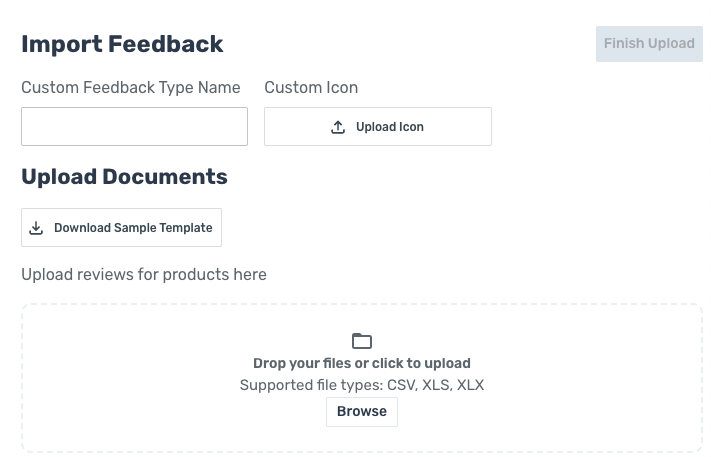Customer Sentiment Analysis
AI-powered customer feedback so you can take action now
Native AI turns insight into impact
Introducing Native AI, the always-on market intelligence platform that helps you understand, innovate, and create ideal experiences for your customers.

A better way to find the answers you need
Create impact through measurable improvements to products, customer experience, and marketing.
-
Analyze millions of qualitative and quantitative data points
-
Automate product and keyword tracking across the web
- Converse with digital clones of your customers in real-time
Insights Dashboard
Customize and export reports with full choice of visualizations. Set up alerts for specific products and keywords, and monitor trends over time in order to predict future consumer behaviors and identify white-space opportunities.


Bring Your Own Data
Upload your first party data in any structured or unstructured format. Our platform is compliant with international data processing regulations to eliminate unnecessary risk.
Digital Twins
Converse with digital clones of your customers or your competitors' customers. Filter by demographic, purchase channel, behavior, and more. Create visualizations and export your results.

Expert White-Glove Service
Our platform is designed for you to be successful independently, but we're here to make sure you’re able to take full advantage of the value Native AI provides.
The Native AI Difference
We're not like other all-in-one insights platforms. Get a peek under the hood.
Data Safety & Privacy
Advanced Orchestration
Synthetic Output Controls
Customer Sentiment Analysis
Customer sentiment analysis is foundational to understanding your market and formulating effective marketing and product strategies. It provides an indispensable knowledge map to decode the feelings and thoughts of customers about your products and services. Customer sentiment translates human emotion to a quantitative score, gauging the customer's positive, negative or neutral feelings towards a product, brand or service. This scoring system provides business insights by translating emotions into measurable data.
Understanding customer sentiment is not an easy process, but when done accurately, it serves as a powerful strategic tool. To measure customer sentiment, companies often leverage feedback mechanisms such as surveys, reviews, and social media platforms. A sample input might be a Twitter sentiment analysis dataset. Twitter, with its clutter of commentary, is a rich pool of raw, unfiltered consumer sentiment which can yield crucial insights for businesses.
Those who are new to the field of customer experience may wonder ‘what is customer sentiment?’. In simple terms, customer sentiment refers to the perception, attitude, and emotions expressed by the customers about a product, service or brand. Why is customer sentiment important, one might ask? In the digital age, the business landscape is hugely impacted by customer opinions. Hence, tracking customer sentiment can provide a competitive edge by predicting market trends, reducing customer churn and personalizing marketing campaigns.
Customer sentiment analysis, often referred to as 'opinion mining', involves the use of natural language processing, text analysis, and computational linguistics to identify and extract subjective information from source materials. By comparing customer feedback with sentiments, businesses can perfect their offerings and improve the overall customer experience. They can also learn about what customers think about their competitors.
Consider an example of a leading smartphone manufacturer. If they run sentiment analysis on reviews of their latest model, they would uncover problems reported by customers, what they loved, and the features they would like to see in future models. Consequently, they could use this information for product enhancements, leading to an improved market share and customer sentiment score. Customer sentiment analysis is often the catalyst for business growth and improvements to customer satisfaction.
Ai For Customer Sentiment Analysis
Harnessing the power of AI for customer sentiment analysis offers businesses invaluable insights as it can process vast amounts of data quicker and more effectively than ever before, making it an excellent tool for such a complex job. Reading each review or bit of customer feedback individually introduces human bias, which is mitigated by machine learning.
A typical customer sentiment analysis example might be using AI algorithms to scan social media posts about a particular product for keywords that indicate the sentiment of the customer. Natural Language Processing, a branch of artificial intelligence, significantly aids in this task by understanding and processing human language as it is naturally spoken or written.
As an example of positive sentiment, consumers may praise a product's incredible features or efficient customer service. For instance, comments like "I love the features on this phone," or "Their customer service was amazing," showcase positive sentiment, offering a clue about customer satisfaction levels.
One practical way of conducting sentiment analysis is through Python, a popular programming language adored for its ease of use and readability. A sentiment analysis example in Python involves using libraries such as TextBlob or NLTK, which are pre-packed with utilities for text processing, and machine learning algorithms.
The implementation of customer sentiment analysis through machine learning offers another level of precision. Machine learning can classify sentiment by training on a large dataset and then using that knowledge to assess new inputs. For instance, the algorithm might learn to associate words such as "awesome" or "excellent" with positivity.
In sum, AI for customer sentiment analysis illuminates consumer needs and wants through its ability to understand, analyze, and determine customer sentiment accurately and in real-time. Acknowledging its importance and incorporating this technology into businesses could yield substantial returns, mostly by revealing crucial business insights that facilitate better decision making.
Best Sentiment Analysis Tools
The evolution of modern-day business dynamics is heavily influenced by customer interaction and their feedback. The best sentiment analysis tools have the ability to interpret complex human emotions deployed in customer reviews. The pressing question remains how these tools are transforming the landscape of customer feedback and their overall contribution to AI sentiment analysis tool development.
Leading corporations, including stalwarts like Google and Amazon, are leveraging the power of sentiment analysis tools for an in-depth understanding of customer behavior. Google sentiment analysis online is one of the primary hooks of their service line that deals with reading customer thoughts about their products or services. Online sentiment analysis tools like Native AI run on algorithms that can decipher the depths of customers' feelings that manifest themselves through their reviews or online engagements.
Similarly, customer sentiment analysis AI adds another dimension to this field. These tools not only analyzes the mood of the user, but also maps customer emotion over time, allowing businesses to see shifts in customer sentiment. This helps them adapt their products and services accordingly. This has made customer sentiment analysis tools an invaluable asset in the current data-driven market scenario.
All these developments underpin the power of customer sentiment and highlight the importance of employing the best sentiment analysis tools to stay competitive.
